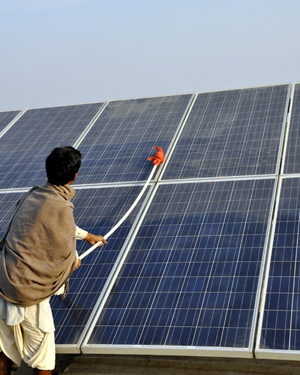SunEdison's plan to bring light to rural India
 Kerosene lamps and cooking fires fueled by animal waste were once the only sources of light for villagers living in the remote enclave of Meerwada, India. Now, the village’s 400 residents rely on off-the-grid solar power installed by SunEdison.
Kerosene lamps and cooking fires fueled by animal waste were once the only sources of light for villagers living in the remote enclave of Meerwada, India. Now, the village’s 400 residents rely on off-the-grid solar power installed by SunEdison.The 14-kilowatt solar-powered microgrid is the first of potentially 30 rural electrification projects SunEdison hopes to install in India over the next 18 months. Ultimately, SunEdison aims to light up 150 villages throughout India, Southeast Asia, Africa and Latin America through as part of its Eradication of Darkness program.
To be clear, this is not a charitable endeavor. SunEdison spokeswoman Dawn Brister calls it a low-profit business model, which will allow the company to expand the project beyond one or two villages. The solar power installations are generally supported with government funds. Villagers pay for the electricity at a rate of about $1 to $1.50 a month, the equivalent of what diesel and kerosene costs, Brister told me in a recent interview. Residents now can have light without fumes. And unlike kerosene, solar can be scaled up to power home appliances and modern electronics. The monthly rate also covers maintenance and collection costs.
SunEdison, a subsidiary of MEMC Electronic Materials, officially kicked off its Eradication of Darkness program in late May. However, it’s been in the works for years.
Suspended solar
SunEdison’s rural electrification plans took root with the government’s completion of the Narmada Canal, a massive infrastructure project that has 19,000 kilometers of gravity-fed branches in the west Indian state of Gujarati. People living in the area now had reliable access to water. Indian Chief Minister Narendra Modi wanted both water and power.
SunEdison designed and installed a 1-megawatt solar installation, which is suspended over a narrow section of the canal located near the city of Sanand. The installation not only generates electricity, some of which is used to pump water, it’s help reduce evaporation and algae growth.

Hot and windy conditions in Gujarti cause water evaporation and algae growth. SunEdison engineers designed the panels to act as floating windbreakers. A thick panel assembly hangs vertically from the first and last row of the structures and is connected to free-floating barrels at the bottom. When the water rises, the barrels float up, keeping the panels from interfering with water flow while blocking the wind.
SunEdison estimates this design feature will save nearly two million gallons of water a year. The panels also reduce algae growth because they prevent sunlight from hitting the water.
Village test project
Bringing off-the-grid solar power to Meerwada was just as a big of a social challenge as it was a technical one. Meerwada is 43 miles from the nearest town and there are no direct roads into the farming village.
Brister credits the close involvement with residents for the solar installation’s success. A volunteer leadership council was established to collect payments, protect the system, resolve any issues and help protect the system from vandals. The council system provides a representative for about every 10 homes.
One resident is now employed to manage and take care of the facility. In the nine months since the power plant began operating, all bills have been paid on time and there hasn’t been any vandalism or attempts to illegally splice into lines, Brister said. That’s an accomplishment in a country where splicing into lines is commonplace and paying for electricity is not.
You can return to the main Market News page, or press the Back button on your browser.

